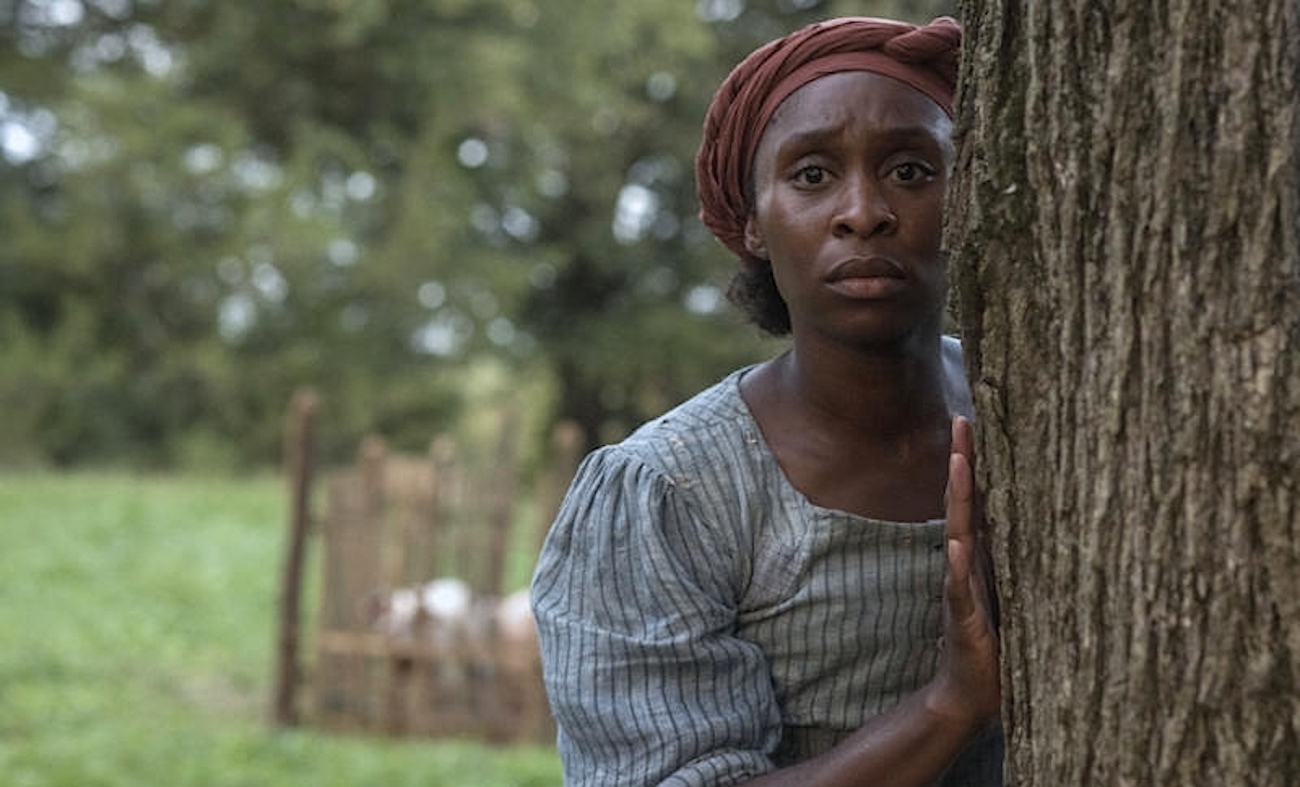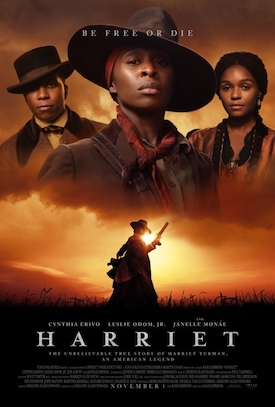 Based on the thrilling and inspirational life of an iconic American freedom fighter, Kasi Lemmons’ riveting Harriet tells the extraordinary tale of Harriet Tubman’s escape from slavery and transformation into one of America’s greatest heroes. Her courage, ingenuity, and tenacity freed hundreds of slaves and changed the course of history. Harriet stars Cynthia Erivo in the title role and features Leslie Odom Jr. and Janelle Monáe.
Based on the thrilling and inspirational life of an iconic American freedom fighter, Kasi Lemmons’ riveting Harriet tells the extraordinary tale of Harriet Tubman’s escape from slavery and transformation into one of America’s greatest heroes. Her courage, ingenuity, and tenacity freed hundreds of slaves and changed the course of history. Harriet stars Cynthia Erivo in the title role and features Leslie Odom Jr. and Janelle Monáe.
Paul Tazewell, the great Broadway costume designer, designed the wardrobe for this powerful film. Tazewell, a six-time Tony nominee, won the Tony for Hamilton along with an Emmy for his work on The Wiz! Live. His stunning costumes for Harriet trace Tubman’s path from fugitive slave to tenacious freedom fighter.
Just as with Hamilton, Tazewell’s costumes are anchored in extensive research. It helped that the Civil War era marked the advent of photography with the famed Daguerreotypes giving Tazewell a trove of inspiration. That informed, for instance, the velvet dress worn by Marie Buchanan (Janelle Monáe), who owns the Philadelphia boarding house that figures prominently in the plot—ornate but tasteful, representative of the life that, to a former slave, is only imaginable in the free North. When Harriet, bedraggled and exhausted after her incredible solo run to freedom, arrives at Marie’s tasteful, well-appointed home in Philadelphia, her crisp silk dresses and delicate shawls practically shimmer.
There are Daguerreotypes of Tubman but obviously none of her very dangerous work leading slaves out of bondage. Reflective of her important, terrifying work, Tazewell and his team created different “stages” of the same costume, such as a red petticoat from her slave dress or a green dress she wears after she returns to the South from her freedom in the north escorting “passengers” along the railroad. Her first incredible escape shows in her wardrobe, progressively more ruined, through mud, blood, and bog water, across each leg of Tubman’s journey. Her clothes literally break down as she tears away the figments of her old life.
As Tubman becomes more comfortable with her new role, she embraces her Joan of Arc like persona, not to mention her male alter ego, Moses. Her wardrobe echoes her new confidence—Union blue pants and jacket with brass buttons and cap or even a top hat on occasion become her uniform and indeed she leads a troop of Buffalo Soldiers into battle in a pale blue coat brandishing a trusty rifle. Even one incredibly detailed navy blue gown, stiff with crinoline petticoats and intricate tight ruffles at the bodice, is as much a statement as the rousing speech she gives to her fellow “conductors” on the Underground Railroad. It is a long way from the plain, blue workaday dress she wears on her initial escape, underscoring how far she has come.
I talked to Paul Tazewell about his remarkable work on this film.
Danny Miller: So nice to talk with you, Paul, I’ve admired your work in the theater for years and was thrilled to see your work in this film. Was doing the research for this film different than for some of your other projects?
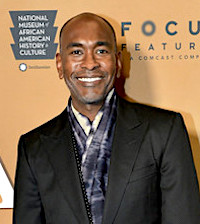 Paul Tazewell: Well, I definitely felt that it was important to be really grounded in history since Harriet Tubman was a real person and quite an icon. I spent a lot of time at the Schomburg Center for Research in Black Culture in New York and, of course, studies the Daguerreotypes from the period. Lucky for us, this was the first era in American history where people started documenting everyday life so I was able to examine portraits of slaves on the plantations as well as free African Americans and the white people of the era.
Paul Tazewell: Well, I definitely felt that it was important to be really grounded in history since Harriet Tubman was a real person and quite an icon. I spent a lot of time at the Schomburg Center for Research in Black Culture in New York and, of course, studies the Daguerreotypes from the period. Lucky for us, this was the first era in American history where people started documenting everyday life so I was able to examine portraits of slaves on the plantations as well as free African Americans and the white people of the era.
I’m thinking of that one famous photo of Harriet Tubman we’ve all seen. Are there many others?
Actually, no, there really aren’t, so that was a challenge. I had to pull together as much research as possible and then make plausible decisions about what Harriet might have worn. But one of the things that I found very inspiring was a newly found photograph of a younger Harriet than we’re used to seeing that’s now at the Smithsonian. It’s a beautiful photograph, there’s a softness to it and an acknowledgment of the fashion of the period that I tried to make sure was a part of her visual story in the film.
She goes through so many personal and physical transitions in the story.
Absolutely. To begin with, if her clothes were not handed down from family members, they were certainly very old. I had to always keep that in mind. And the dress she escapes in had to show an enormous amount of wear and tear to the point where it’s deteriorating off of her body. It’s just not able to hold together after jumping off a bridge, being swept through the rapids, everything she went through. By the time she reaches freedom, it’s pretty much falling off of her.
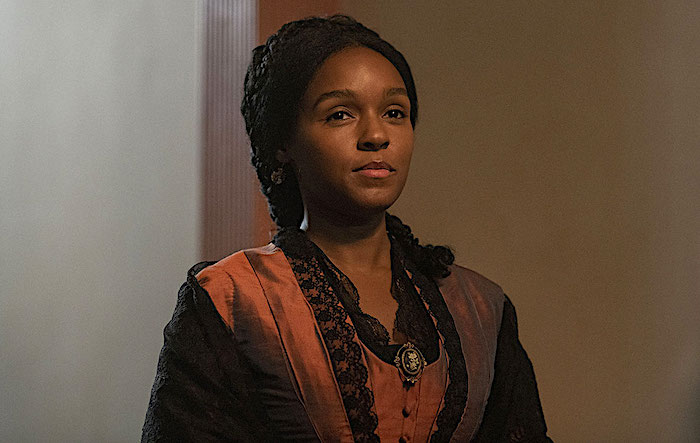
Janelle Monáe as Marie Buchanan
And then she makes it to Philadelphia and meets Marie Buchanan who looks unlike any Black woman Harriet has ever seen. You can see the wonder in her eyes when she first sees Marie.
Yes, and Marie becomes a great influence on Harriet including what she wears. As a designer, it was very fun to create the different looks for Harriet when she became a master of disguise in the Underground Railroad. She was trying to stay under the radar of the slave catchers who initially thought she was a man but Harriet adopted many different looks that allowed aspects of her personality to come through, some female, some male like when she dresses like some of the Black sailors of the time.
I love it because you see her clothes reflect her emotional journey and empowerment throughout the film. Was it hard to research the proper color palette to use since the Daguerreotypes are obviously not in color?
We have a lot of knowledge from clothes that have survived and from paintings about what colors and fabrics were available at that time. We knew the fiber content that we needed to work with and we actually used a significant number of genuine period costumes in the film, mostly for secondary characters, including a couple of pieces that we copied for Harriet’s look. Janelle Monáe, who played Marie, wore one dress that was a beautiful silk stripe from the period.
Wow, it’s a miracle that any of those survived.
Yes, it’s pretty remarkable. Of course ,these were dresses that were completely hand-sewn. And when you see the intensity and richness of the colors, that gave us license to use those colors in the costumes we created. Some of the authentic period clothes helped support where I wanted to go emotionally with the different characters.
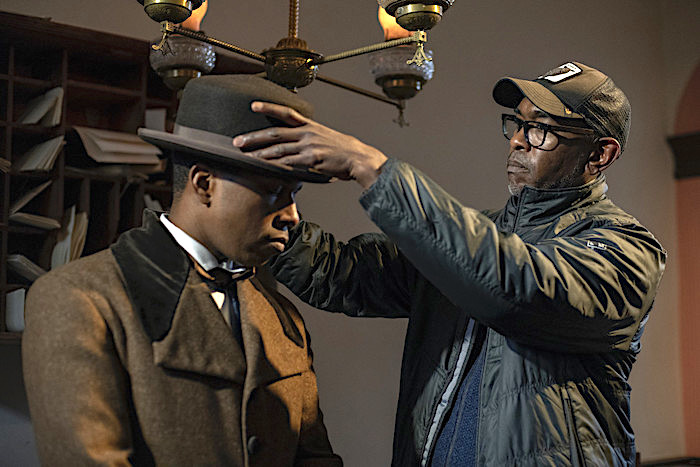
Paul Tazewell adjusting Leslie Odom Jr.’s costume
With all the hardships these characters were going through, I imagine that the layering of dirt and grime was especially important. I assume that you were the one art directing the filth and the deterioration of the clothing?
Oh yes, that’s my job. We’d start by carefully going through the script and determining how many times we’d see Harriet in a dress on her journey from Point A to Point B and then I would take everything that’s happened to her into consideration and start imagining what the different levels of distress would be.
You must have had to make so many versions of some of those outfits.
Yes, I remember with some we had about eight versions at varying levels of decay, plus at least four more for Cynthia’s stunt double. The reality is that the dress she was wearing during her escape would already be quite distressed the first time we see it, so that was the baseline for all the copies, and then we had to go from there to make the condition of the dress worse and worse.
Fascinating. Before I go, as a classic movie lover, I have to ask you about the project you just completed, Steven Spielberg’s new take on West Side Story.
Oh, it was a really exciting summer. We filmed mostly in New York with a little bit in Patterson, New Jersey. We stuck to the time period of when the original was created, the 1950s, and it was such a delight working with Spielberg. I think it’s going to be a stunning film.
But was it a little nerve-wracking that you all knew that many of us have every frame of the original film memorized?
I hope that we’ve been able to create a parallel version of West Side Story that people will grow to love. The cast is out of this world — they’re all young and so full of life. And we have Rita Moreno in our cast, too, so that’s also a big plus and a connection to the original film. It was a great group all around. There’s no question that the original film is beloved and I hope our film just adds to that experience in the same way seeing a new stage production of West Side Story does, which we’re actually going to be treated to very soon.
Frankly, knowing that Rita Moreno was the only actual Puerto Rican actor in the original cast makes me excited about seeing a more diverse group in the new movie.
Absolutely, you’re going to see a lot of diversity in our cast.
Well, thanks so much for the chat, I really hope that people are flocking to Harriet because I think it’s a very important film. And good luck with West Side Story.
We can talk more about that next year!

